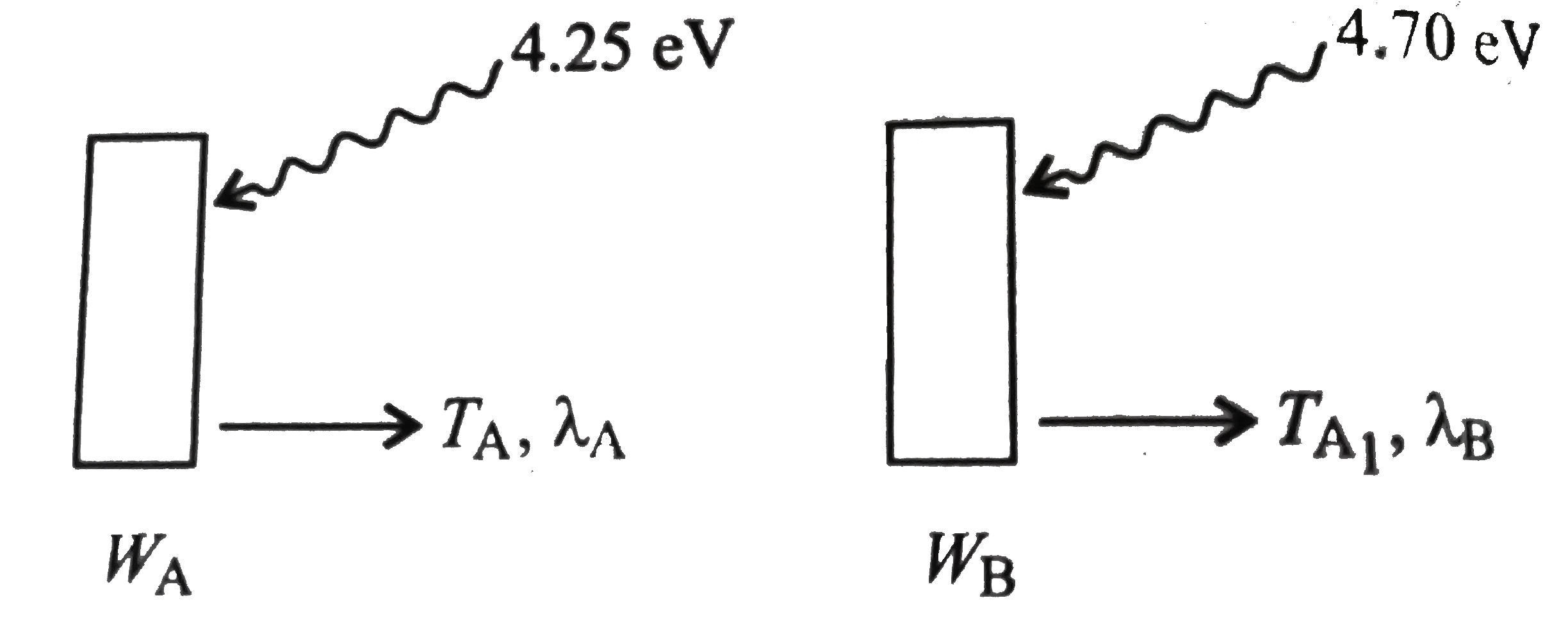When photon of energy 25eV strike the surface of a metal A, the ejected photelectron have the maximum kinetic energy photoelectrons have the maximum kinetic energy TAeV and de Brogle wavelength λA .The another kinetic energy of photoelectrons liberated from another metal B by photons of energy 4.76eV is TB=(TA=1.50)eV .If the de broglie wavelength of these photoelectrons is λB=2λA then
i.(WB)A=2.25eVII.(W0)B=4.2eV
IIITA=2.0eVIV.TB=3.5eV
I,II
II,III,IV
I,II,III
I,II,III,IV

WA+TA=4.25⇒WA=2.25eV
WA+TB=4.7⇒WB=4.2eV
λB=2λA
⇒KEA=4KEB
⇒TA=4(TB)
⇒TA=2.0eV
TA=0.5eV
Hence option c
Topper's Solved these Questions
- ATOMIC STRUCTUREBOOK - CENGAGE CHEMISTRYCHAPTER - ATOMIC STRUCTUREEXERCISE - Exercises (Subjective)
52 Videos
- ATOMIC STRUCTUREBOOK - CENGAGE CHEMISTRYCHAPTER - ATOMIC STRUCTUREEXERCISE - Exercises Linked Comprehension
50 Videos
- APPENDIX - INORGANIC VOLUME 1BOOK - CENGAGE CHEMISTRYCHAPTER - APPENDIX - INORGANIC VOLUME 1EXERCISE - chapter-7 Single correct answer
1 Videos
- CHEMICAL BONDING AND MOLECULAR STRUCTUREBOOK - CENGAGE CHEMISTRYCHAPTER - CHEMICAL BONDING AND MOLECULAR STRUCTUREEXERCISE - Archives Subjective
15 Videos
Similar Questions
When photons of energy 4.25eV strike the surface of a metal A, the ejected photoelectrons have maximum kinetic energy, TA (expressed in eV) and deBroglie wavelength λA. The maximum kinetic energy of photoelectrons liberated from another metal B by photons of energy 4.20V is TB=TA−1.50eV. If the deBroglie wavelength of those photoelectrons is λB=2λA then
View SolutionWhen photons of energy 4.25 eV strike the surface of a metal A, the ejected photoelectrons have maximum kinetic energy λA. The maximum kinetic energy of photoelectrons liberated from another metal B by photons of energy 4.70eVisTB=(TA−1.50)eV. If the de Broglie wavelength of these photoelectrons is λB=2λA, then select the correct statement statement (s)
View Solution
Knowledge Check
When photons of energy 4.25eV strike the surface of a metal A, the ejected photoelectrons have maximum kinetic energy, TA (expressed in eV) and deBroglie wavelength λA. The maximum kinetic energy of photoelectrons liberated from another metal B by photons of energy 4.20V is TB=TA−1.50eV. If the deBroglie wavelength of those photoelectrons is λB=2λA then
AThe work function of A is 2.25 eVBThe work function of B is 3.70 eVCTA=2.00eVDTB=2.75eVWhen photons of energy 4.25eV strike the surface of a metal A, the ejected photoelectrons have maximum kinetic energy, TA (expressed in eV) and deBroglie wavelength λA. The maximum kinetic energy of photoelectrons liberated from another metal B by photons of energy 4.20V is TB=TA−1.50eV. If the deBroglie wavelength of those photoelectrons is λB=2λA then
Athe work function of A is 2.25 eVBthe work function of B is 3.70 eVCTA=2.00eVDTB=2.75eVWhen photons of energy 4.25eV strike the surface of a metal A, the ejected photoelectrons have maximum kinetic energy, TA (expressed in eV) and deBroglie wavelength λA. The maximum kinetic energy of photoelectrons liberated from another metal B by photons of energy 4.20V is TB=TA−1.50eV. If the deBroglie wavelength of those photoelectrons is λB=2λA then
AThe work function of A is 1.50eVBThe work function of B is 4.0 eVCTA=3.2eVDAll of the above
When a radiation of energy 5eV falls on a surface,the emitted photoelectrons have a maximum kinetic energy of 3eV .The stopping potential is
View SolutionWhen photones of energy 4.0 eV fall on the surface of a metal A, the ejected photoelectrons have maximum kinetic energy TA ( in eV) and a de-Broglie wavelength λA. When the same photons fall on the surface of another metal B, the maximum kinetic energy of ejected photoelectrons is TB=TA−1.5eV. If the de-Broglie wavelength of these photoelectrons is λB=2λA, then the work function of metal B is
View Solutionphotons of energy 4.25eV strike the surface of metal A, the ejection photoelectric have maximum kinetic energy TAeVe≠rgy4.70eVisTB=(TA−1.50)eV if the de Brogle wavelength of these photoelec tron is λB=2λA, then
View SolutionAn electron is having a kinetic energy of 50 eV. Its de-Broglie wavelength is
View SolutionAn electron is having a kinetic energy of 50 eV. Its de broglie wavelength is
View Solution
